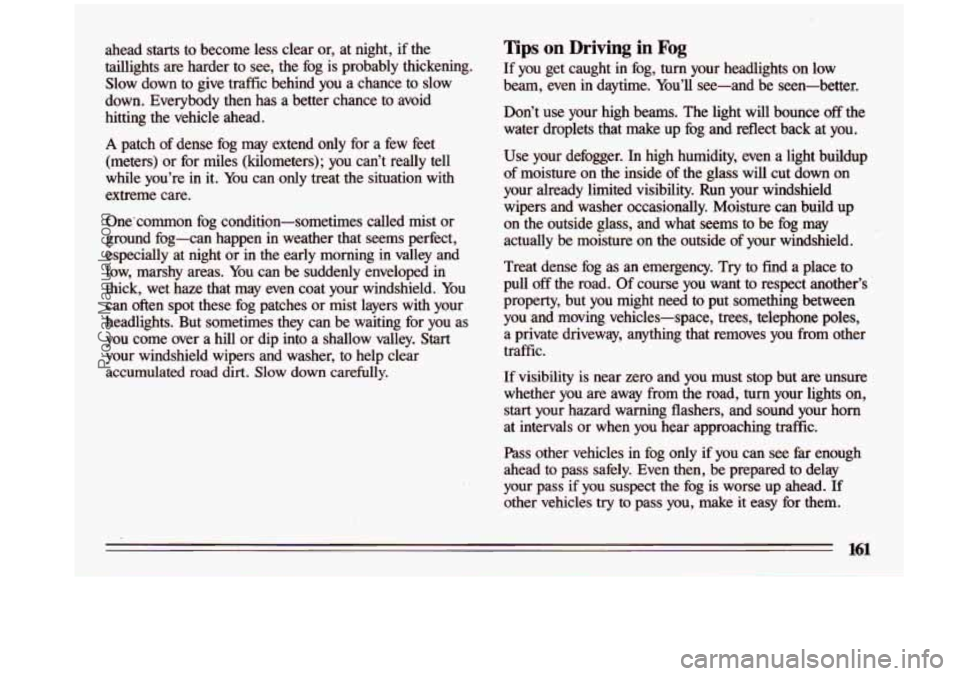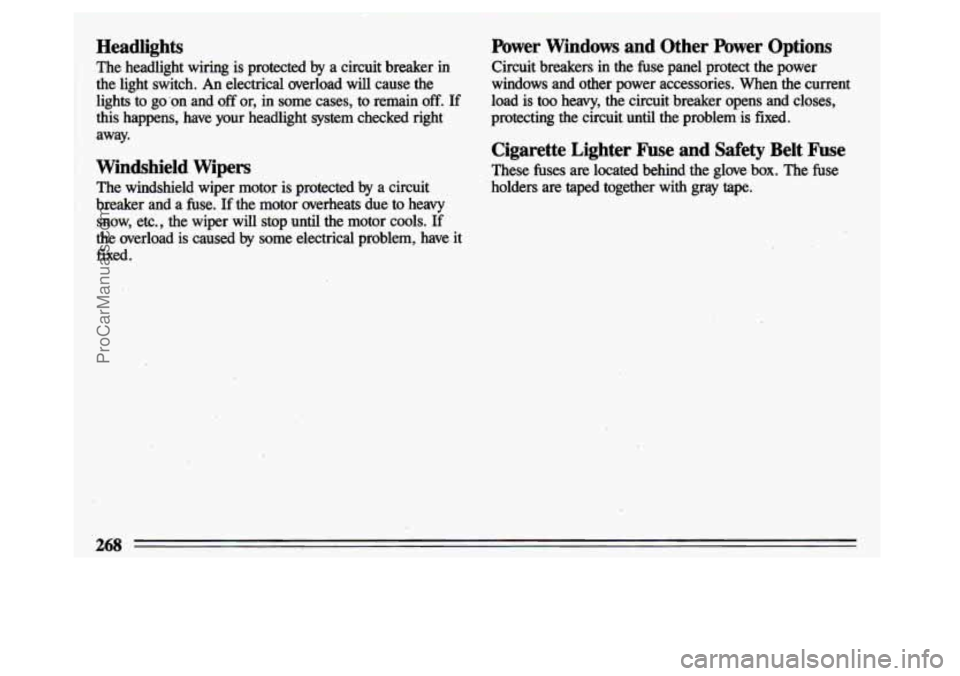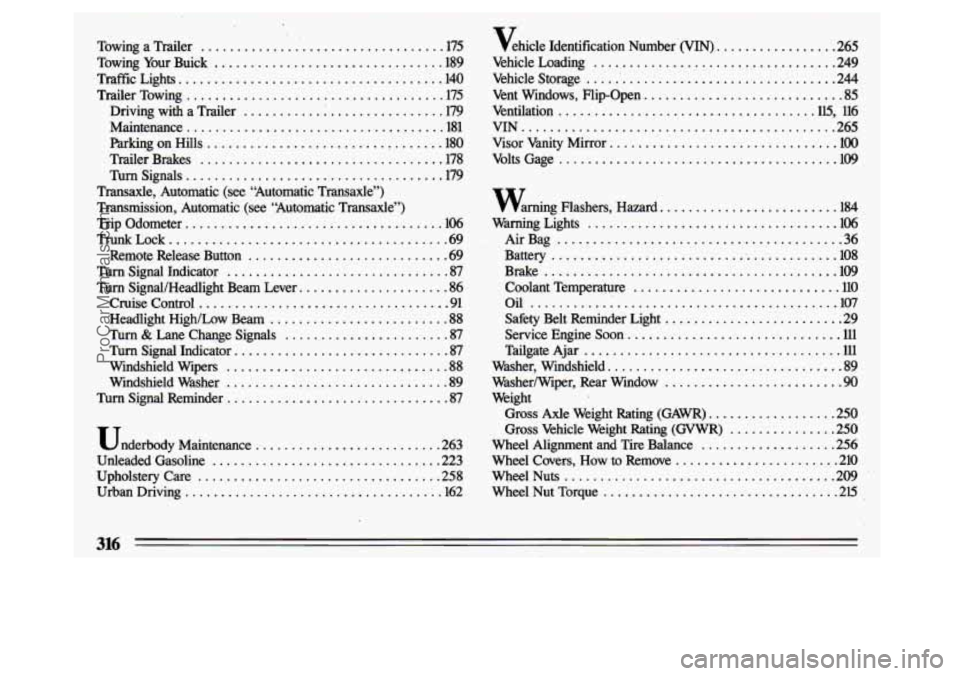1993 BUICK CENTURY wipers
[x] Cancel search: wipersPage 65 of 324

n
part 2 Features and Controls
Here you can learn about the many standard and optional features on your Buick. and informat\
ion on starting.
shifting and braking . Also explained are the instrument panel and the warning systems that tell you if everything
is working properly-and what to do if you have a problem .
Part 2 includes:
Keys ........................................................................\
........
Locks ........................................................................\
...... 65
Remote Keyless Entry System ........................................................... 66
New Vehicle Break-In ................................................................. 72
Ignition ........................................................................\
..... 73
Starting Your Engine .................................................................. 74
Shifting the Transaxle ........................................... : ..................... 77
parking Brake ........................................................................\
80
ShiftingIntoPark ..................................................................... 81
Windows ........................................................................\
... 84
Horn ........................................................................\
....... 86
TiltSteeringWheel ................................................................... 86
Turn Signal/Headlight Beam Lever ....................................................... 86
Windshield Wipers, Washer ........................................................... 88
CruiseControl ..................................................................... 91
InteriorLights ....................................................................... \
95
Headlights ........................................................................\
.. 95
Mirrors ........................................................................\
..... 98
Instrument Panel ..................................................................... 105
Warning Lights, Gages and Indicators .................................................. 106
63
ProCarManuals.com
Page 88 of 324

Horn
You can sound the horn by pressing the horn symbol on
your steering wheel.
Tilt Steering Wheel (Option)
b
-.
A tilt steering wheel allows
you
to adjust the steering
wheel before you drive. You
can
also raise it to the
highest level
to give your
legs more room when you
exit and enter the vehicle.
To tilt the wheel, hold the
steering wheel and pull the
lever. Move the steering
wheel to a comfortable
level, then release the lever
to lock the wheel in place.
The I’urn SignaUHeadlight Beam
Lever
The lever on the left side of the steering column includes
your:
Turn Signal and Lane Change Indicator
Headlight High-Low Beam
Windshield Wipers
Windshield Washer
Cruise Control (Option)
86
ProCarManuals.com
Page 90 of 324

Headlight Highhw Beam Windshield Wipers
To change the headlights
from low beam to high, or
high to low, pull the
turn
signal lever all the way
toward
you. Then release
it. When the high beams
are on,
.this blue light on
the instrument panel also will be on.
i
I
You control the windshield wipers by turging the band
marked
“WIPERI’
For a single wiping cycle, turn the band to “MIST? Hold it there until the wipers
start, then let go. The wipers will
stop after one cycle.
If you want more cycles, hold the
band on “MIST” longer.
For steady wiping at low speed,
turn the band away from
YOU to the “LO” position. For high speed wiping, turn
the band further, to “HI? To stop the wipers, move the
band to “OFF?
88 .I
ProCarManuals.com
Page 91 of 324

Low Speed Delay Wipers (Option)
You can set the wiper speed for a long or short delay
between wipes.
‘ms can be very useful in light rain or
snow.
Turn the band to choose the delay time. The closer
to
“LO:’ the shorter the delay.
If you push the paddle less than one second, washer fluid
will spray three to four times while the wiper blades
cycle.
If you push the paddle longer than one second,
washer fluid will spray as long
as the paddle is held.
When you release the paddle, the wiper blades will cycle
I
- .I - three to four more times. 1
A CAUTION:
I If you have the standard wipers, the wipers will keep
going
in “LO” until you turn the wiper control to -
“OFF.” Damaged wiper blades may prevent you’irom
seeing well enough to drive safely.
To avoid If you have the optional low speed delay wipers, the
damage, be sure to clear ice and snow from wipers will clear the window and then either stop or
the wiper blades before using them. If they’re
frozen to the windshield, carefully loosen or
thaw them.
If your blades do become b 1.
-
return to your preset speed.
I damaged, gefnew blades or blade inserts.
I
Heavy snow or ice can overload your wipers. A circuit
breaker in the motor will
stop them until the motor cools.
Clear away snow or ice to prevent an overload.
Windshield Washer
At the top of the turn signal/headlight beam lever there’s
a paddle with the word “PUSH”
on it. To spray washer
fluid on the windshield, push the paddle.
a Driving without washer fluid can be dangerous.
A bad mud splash can block your vislon. ybu
could hit another vehicle or go off the mad.
Check your washer fluid level often.
* In freezing weather, don’t use your washer
untll the windshield is warmed. Otherwim
the washer fluid
can form ice on the
windshield, blocking
put vision.
ProCarManuals.com
Page 97 of 324

Lights
Interior Lights/Instrument Panel Intensity Control
I+
Headlights
*P
I PF
You can brighten or dim the
instrument panel lights by
rotating the control up or
down. To turn on the
interior courtesy lights,
rotate the control all the
way up to
“HI:’
Press the switch marked “P” to
turn on:
Parking Lights
Side Marker Lights
Taillights
License Plate Lights
Instrument Panel Lights
-‘(J- Press the , switch to turn on the headlights,
together with:
Parking Lights
Side Marker Lights
Taillights
License Plate Lights
Instrument Panel Lights
Press
“OFF” to turn off the lights.
Operation of Lights
Although your vehicle’s lighting system (headlamps,
parking lamps, fog lamps, side marker lamps’and tail
lamps) meets
all applicable federal lighting requirements,
certain States and Provinces may apply their own lighting
regulations that may require special attention before you
operate these lamps. For example, some jurisdictions
may require that you operate your lower beam lamps
with fog lamps at
all times, or that headlamps be turned
on whenever you must use your windshield wipers.
In
addition, most jurisdictions prohibit driving solely with
parking lamps, especially at dawn or dusk.
It is
recommended that you check with your own State Or
Provincial highway authority for applicable lighting
regulations.
95
ProCarManuals.com
Page 163 of 324

ahead starts to become less clear or, at night, if the
taillights are harder to see, the fog is probably thickening.
Slow down to give traffic behind you a chance to slow
down. Everybody then has a better chance to avoid hitting the vehicle ahead.
A patch of dense fog may extend only for a few feet
(meters) or for miles (kilometers); you can’t really tell
while you’re in it. You can only treat the situation with
extreme care.
One‘common fog condition-sometimes called mist or
ground fog-can happen in weather that seems perfect,
especially at night or
in the early morning in valley and
low, marshy areas. You can be suddenly enveloped in
thick, wet haze that may even coat your windshield. You
can often spot these fog patches or mist layers with your
headlights. But sometimes they can be waiting for you as
you come over a hill or dip into a shallow valley.
Start
your windshield wipers and washer, to help clear
accumulated
road dirt. Slow down carefully.
Tips on Driving in Fog
If you get caught in fog, turn your headlights on low
beam, even in daytime. You’ll see-and be seen-better.
Don’t use your high beams. The light will bounce
off the
water droplets that make up fog and reflect back at you.
Use your defogger. In high humidity, even a light buildup
of moisture on the inside of the glass will cut down on
your already limited visibility. Run your windshield
wipers and washer occasionally. Moisture can build up
on the outside glass, and what seems to be fog .may
actually be moisture on the outside
of your windshield.
Treat dense fog as an emergency.
Try to find a place to
pull off the road. Of course you want to respect another’s
property, but you might need to put something between
you and moving vehicles-space, trees, telephone poles,
a private driveway, anything that removes you from other
traffic.
If visibility is near zero and you must stop but
are unsure
whether you are away from the road, turn your lights on,
start your hazard warning flashers, and sound your horn
at intervals or when you hear approaching traffic.
Pass other vehicles in fog only if you can see far enough
ahead to pass safely. Even then, be prepared
to delay
your pass if you suspect the fog is worse up ahead.
If
other vehicles try to pass you, make it easy for them.
161
ProCarManuals.com
Page 270 of 324

Headlights
The headlight wiring is protected by a circuit breaker in
the light switch. An electrical overload will cause the
lights
to go 'on and off or, in some cases, to remain off. If
this happens, have your headlight system checked right
away.
Windshield Wipers
The windshield wiper motor is protected by a circuit
breaker and a fuse.
If the motor overheats due to heavy
snow, etc., the wiper will
stop until the motor cools. If
the overload is caused by some electrical problem, have it
fixed.
Power Windows and Other Power Options
Circuit breakers in the.fuse panel protect the power
windows and other power accessories. When the current
load is
too heavy, the circuit breaker opens and closes,
protecting the ,circuit until the problem
is fixed.
Cigarette Lighter Fuse and Safety Belt Fuse
These fuses are located behind the glove box. The fuse
holders are
taped together with gray tape.
268
ProCarManuals.com
Page 318 of 324

Towing a Trailer .................................. 175
Towing Your Buick
................................ 189
Traf%lc Lights ...................................... 140
Trailer Towing .................................... 175
Driving with a Trailer ........... i ............... -179
Maintenance. ................................... 181
Parking on Hills ......................... .. ....... 180
Trailer Brakes .................................. 178
Turn Signals .................................... 179
Transaxle, Automatic (see “Automatic Transaxle”)
Transmission, Automatic (see ‘Automatic Transaxle”)
Trip Odometer.
................................... 106
Trunk Lock
....................................... 69
Remote Release Button ............................ 69
Turn Signal Indicator ............................... 87
Turn Signal/Headlight Beam Lever ..................... 86
Cruise Control ................................... 91
Headlight High/Low Beam ......................... 88
Turn & Lane Change Signals ....................... 87
Turn Signal Indicator ............................... 87
Windshield Wipers .............................. -88
windshield Washer ................................. 89
Turn Signal Reminder ............................... 87
underbody Maintenance .......................... 263
Unleaded Gasoline ................................ 223
Upholstery Care .................................. 258
Urban Driving .................................. 1 . 162
Vehicle Identification Number.(VIN) ................. 265
Vehicle hading .................................. 249
Vehicle Storage .................................... 244
Vent Windows, Flip-Open ............................ 85
Ventilation .................................... U. 116
VIN ......................................... : ... 269
Visor Vanity Mirror. ............................... 100
Volts Gage ....................................... 109
warning Flashers. Hazard ......................... 184
Warning Lights .................................. -106
AirBag ........................................ 36
Battery ......................................... 108
Brake ......................................... 109
Coolant Temperature
............................. 110
Oil ........................................... 107
Safety Belt Reminder Light ......................... 29
Service Engine Soon .............................. 111
TailgateAjar .................................... 111
Washer, Windshield .................................. 89
WasherNiper, Rear Window ......................... 90
Weight
Gross Axle Weight Rating (GAWR)
................... 250
Gross Vehicle Weight Rating (GVWR) ............... 250
Wheel Alignment and Tire Balance ................... 256
Wheel Covers, How to Remove ....................... 210
WheelNuts ...................................... 209
Wheel Nut Torque ................................. 215
316
ProCarManuals.com